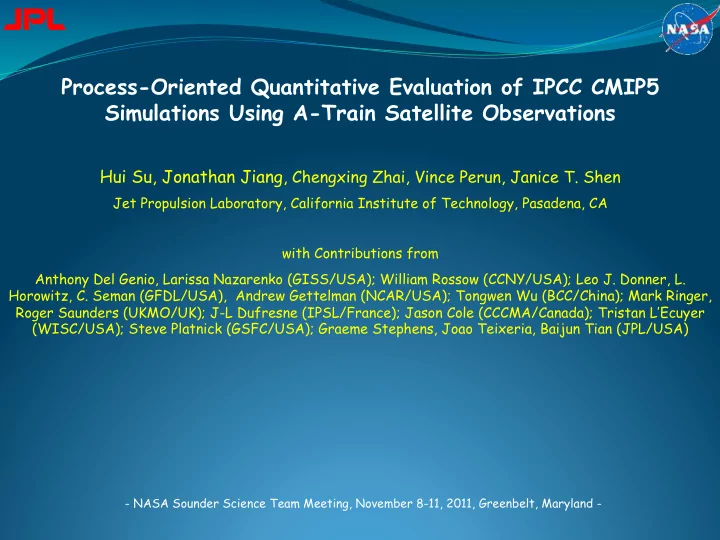

Process-Oriented Quantitative Evaluation of IPCC CMIP5 Simulations Using A-Train Satellite Observations Hui Su, Jonathan Jiang , Chengxing Zhai, Vince Perun, Janice T. Shen Jet Propulsion Laboratory, California Institute of Technology, Pasadena, CA with Contributions from Anthony Del Genio, Larissa Nazarenko (GISS/USA); William Rossow (CCNY/USA); Leo J. Donner, L. Horowitz, C. Seman (GFDL/USA), Andrew Gettelman (NCAR/USA); Tongwen Wu (BCC/China); Mark Ringer, Roger Saunders (UKMO/UK); J-L Dufresne (IPSL/France); Jason Cole (CCCMA/Canada); Tristan L’Ecuyer (WISC/USA); Steve Platnick (GSFC/USA); Graeme Stephens, Joao Teixeria, Baijun Tian (JPL/USA) - NASA Sounder Science Team Meeting, November 8-11, 2011, Greenbelt, Maryland -
Ø To use A-Train satellite observations to evaluate CMIP5 simulations of clouds and water vapor and thus contribute to IPCC AR5 - Cloud feedback remains the largest uncertainty for climate projections. - Accurate simulations of current climate is a necessary condition for credible future projections. Image credit: NASA Image credit: Wikipedia/NOAA
1. Vertical profiles of water vapor and clouds 2. Simultaneous multiple measurements enable physics-driven process understanding 3. Knowledge of observational uncertainties enables quantitative assessment See Jiang et al. (2011, to be submitted)
Performance of current climate simulations for water vapor and clouds Impact on current climate processes that govern the radiation and precipitation simulations Simulations of water vapor Impact on future climate and clouds in future climate energy and water cycles
Performance of current climate simulations for water vapor and clouds
Jiang et al. (2011, to be submitted)
Jiang et al. (2011, to be submitted)
Jiang et al. (2011, to be submitted)
Jiang al. (2011, to be submitted)
Performance of current climate simulations for water vapor and clouds processes that govern the simulations
Performance of current climate simulations for water vapor and clouds Impact on current climate radiation and precipitation
CloudSat-CERES
600 hPa CloudSat-GPCP
• Significant improvements are found from CMIP3 to CMIP5 in simulated IWP and LWP. • Water vapor is generally better simulated than clouds. • Model spreads in the upper troposphere are much larger than those in the lower and middle troposphere. • The simulated relationships of clouds with large-scale dynamic and thermodynamic regimes are drastically different -> large errors in model physics • Boundary layer clouds constitute the largest spread for the net cloud forcing sensitivity • Mid-tropospheric clouds constitute the largest spread for the precipitation sensitivity
More work is needed … ...
200 hPa
100 hPa
215 hPa
900 hPa
Recommend
More recommend